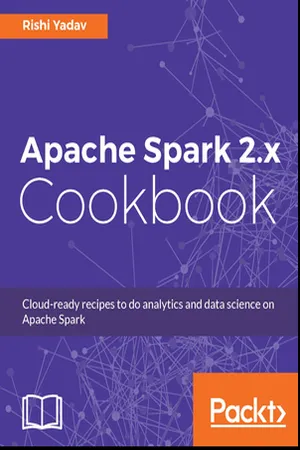
Apache Spark 2.x Cookbook
Rishi Yadav
- 294 pages
- English
- ePUB (mobile friendly)
- Available on iOS & Android
Apache Spark 2.x Cookbook
Rishi Yadav
About This Book
Over 70 recipes to help you use Apache Spark as your single big data computing platform and master its librariesAbout This Book• This book contains recipes on how to use Apache Spark as a unified compute engine• Cover how to connect various source systems to Apache Spark• Covers various parts of machine learning including supervised/unsupervised learning & recommendation enginesWho This Book Is ForThis book is for data engineers, data scientists, and those who want to implement Spark for real-time data processing. Anyone who is using Spark (or is planning to) will benefit from this book. The book assumes you have a basic knowledge of Scala as a programming language.What You Will Learn• Install and configure Apache Spark with various cluster managers & on AWS• Set up a development environment for Apache Spark including Databricks Cloud notebook• Find out how to operate on data in Spark with schemas• Get to grips with real-time streaming analytics using Spark Streaming & Structured Streaming• Master supervised learning and unsupervised learning using MLlib• Build a recommendation engine using MLlib• Graph processing using GraphX and GraphFrames libraries• Develop a set of common applications or project types, and solutions that solve complex big data problemsIn DetailWhile Apache Spark 1.x gained a lot of traction and adoption in the early years, Spark 2.x delivers notable improvements in the areas of API, schema awareness, Performance, Structured Streaming, and simplifying building blocks to build better, faster, smarter, and more accessible big data applications. This book uncovers all these features in the form of structured recipes to analyze and mature large and complex sets of data.Starting with installing and configuring Apache Spark with various cluster managers, you will learn to set up development environments. Further on, you will be introduced to working with RDDs, DataFrames and Datasets to operate on schema aware data, and real-time streaming with various sources such as Twitter Stream and Apache Kafka. You will also work through recipes on machine learning, including supervised learning, unsupervised learning & recommendation engines in Spark.Last but not least, the final few chapters delve deeper into the concepts of graph processing using GraphX, securing your implementations, cluster optimization, and troubleshooting.Style and approachThis book is packed with intuitive recipes supported with line-by-line explanations to help you understand Spark 2.x's real-time processing capabilities and deploy scalable big data solutions. This is a valuable resource for data scientists and those working on large-scale data projects.
Frequently asked questions
Information
Getting Started with Apache Spark
- Leveraging Databricks Cloud
- Deploying Spark using Amazon EMR
- Installing Spark from binaries
- Building the Spark source code with Maven
- Launching Spark on Amazon EC2
- Deploying Spark on a cluster in standalone mode
- Deploying Spark on a cluster with Mesos
- Deploying Spark on a cluster with YARN
- Understanding SparkContext and SparkSession
- Understanding Resilient Distributed Datasets (RDD)
Introduction

- Outcome-driven applications
- Data transformation pipelines
Leveraging Databricks Cloud
Table of contents
- Title Page
- Copyright
- Credits
- About the Author
- About the Reviewer
- www.PacktPub.com
- Customer Feedback
- Preface
- Getting Started with Apache Spark
- Developing Applications with Spark
- Spark SQL
- Working with External Data Sources
- Spark Streaming
- Getting Started with Machine Learning
- Supervised Learning with MLlib — Regression
- Supervised Learning with MLlib — Classification
- Unsupervised Learning
- Recommendations Using Collaborative Filtering
- Graph Processing Using GraphX and GraphFrames
- Optimizations and Performance Tuning